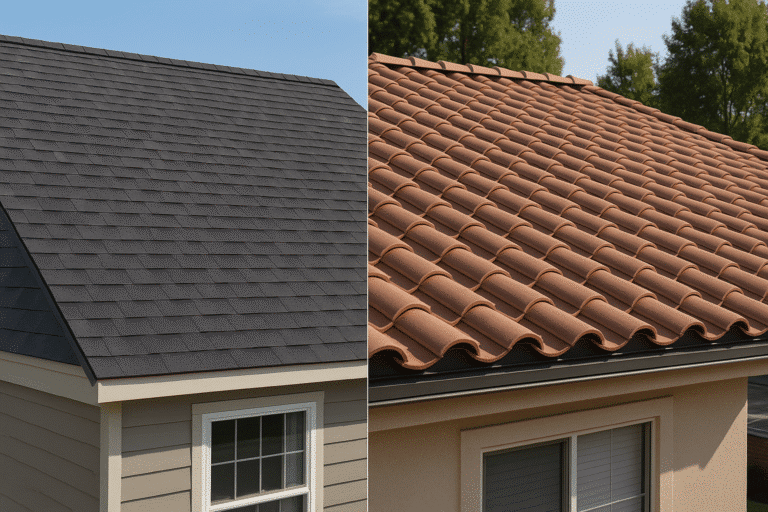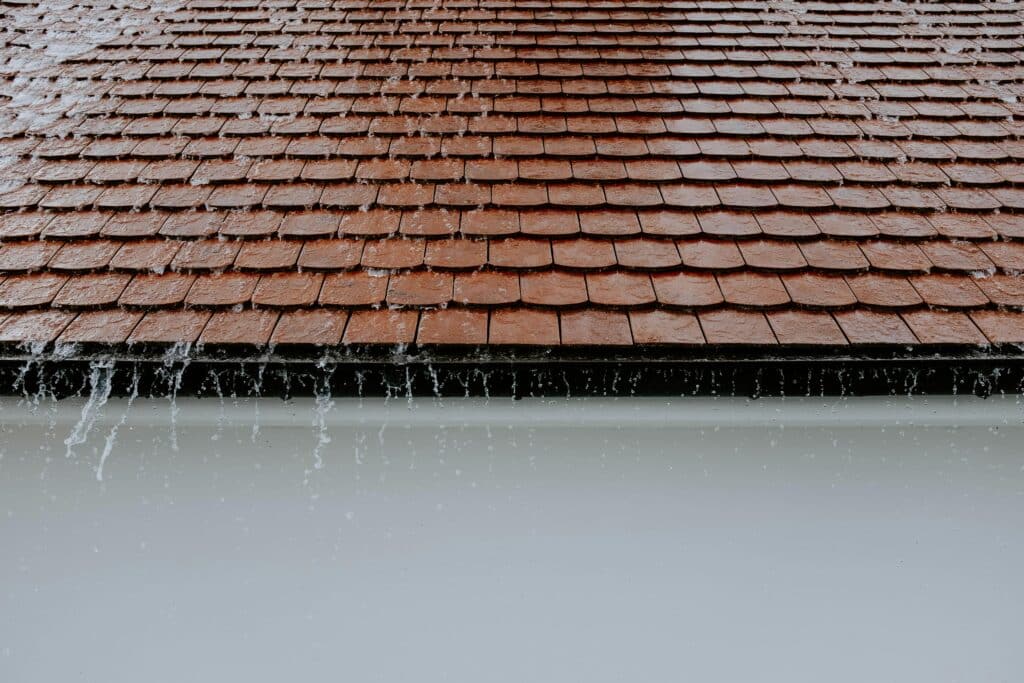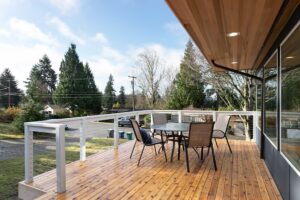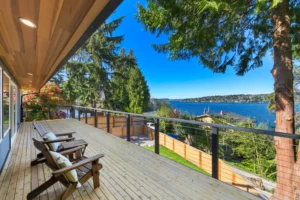When homeowners in Puget Sound start comparing tile roof vs shingle roof, one of the first questions they ask is: which lasts longer in our rainy, windy climate? Both roofing options have their strengths—shingles are affordable and versatile, while tile roofs offer unmatched durability and timeless curb appeal. But choosing between tile vs shingle roof isn’t just about looks; it’s about balancing lifespan, maintenance, cost, and how well your roof will perform against the Pacific Northwest’s constant rain, moss growth, and occasional storms.
In this guide, we’ll break down the differences, from installation and maintenance requirements to cost and long-term value, so you can make an informed decision about the best roofing system for your Puget Sound home.
What Is Shingle Roofing?
Shingle roofing is the most common roof type in the United States, and for good reason. Asphalt shingles in particular are affordable, versatile, and easy to install—making them a go-to option for many Puget Sound homeowners. When comparing tile roof vs shingle roof, shingles stand out as the budget-friendly choice that still provides reliable protection against rain, wind, and moss growth common in the region.
Advantages of Shingle Roofs
- Cost-Effective – Asphalt shingles are one of the most affordable roofing materials, both in terms of upfront cost and installation.
- Variety of Styles – Available in many colors, textures, and designs, shingle roofs can complement everything from traditional homes to modern builds.
- Ease of Installation & Repair – Shingle roofing is lightweight and simple to replace, which means repairs are quicker and less expensive compared to tile.
- Decent Lifespan for the Price – While shingles don’t last as long as tile, high-quality architectural shingles can still provide 25–30 years of reliable performance when maintained properly.
Disadvantages of Shingle Roofs
- Shorter Lifespan – When weighing tile vs shingle roof, shingles usually last 20–30 years, while tile can last 50+ years.
- Lower Durability – Asphalt shingles are more prone to cracking, lifting, or losing granules during heavy storms and high winds.
- Maintenance Needs – In Puget Sound’s damp climate, shingles are more likely to develop moss, algae, and staining, requiring regular cleaning.
- Environmental Impact – Shingles are less eco-friendly than tile roofing since they are petroleum-based and need to be replaced more frequently.
What Is Tile Roofing?
Tile roofing is one of the most durable and aesthetically appealing options available for homeowners. When comparing shingle roof vs tile roof, tiles stand out for their longevity, resistance to weather, and timeless curb appeal. Commonly made from clay, concrete, or composite alternatives like Brava Roof Tile, tile roofs can withstand the Pacific Northwest’s rainy winters and occasional storms while offering a unique architectural look.
Advantages of Tile Roofs
- Exceptional Longevity – A well-installed tile roof can last 50–100+ years, far outpacing shingles in terms of lifespan.
- Durability Against the Elements – Tile roofing is naturally resistant to fire, insects, rot, and moisture, making it an excellent choice for Puget Sound’s wet climate.
- Energy Efficiency – Tile provides superior insulation, keeping homes cooler in the summer and warmer in the winter, which can help reduce energy costs.
- Curb Appeal & Home Value – Tile vs shingle roof often comes down to aesthetics, and tile offers a premium, classic look that can significantly increase property value.
- Eco-Friendly Options – Modern composite tiles like Brava are made from sustainable materials, combining the look of clay or slate with lower weight and minimal maintenance needs.
Disadvantages of Tile Roofs
- Higher Upfront Cost – Tile roofs are more expensive to install than shingles, often requiring a larger investment at the start.
- Heavy Material – Clay and concrete tiles are very heavy, which may require additional structural support in some homes.
- Complex Installation – Unlike shingles, tile roofing requires professional expertise and careful installation. Repairs can also be more specialized and costly.
- Fragility of Traditional Tiles – While durable, clay and concrete tiles can break if walked on or struck by heavy debris, making them more challenging to maintain without expert help.

Shingle Roof vs Tile Roof Lifespan and Durability
When deciding between a shingle roof vs tile roof, longevity and durability are two of the most important factors for homeowners in Puget Sound’s wet, moss-prone climate. The Pacific Northwest’s heavy rainfall, occasional snow, and strong winds make roof performance especially critical.
Average Lifespan in Puget Sound
- Asphalt Shingle Roofs – On average, asphalt shingles last 15–25 years in Puget Sound. While affordable and versatile, they’re more prone to algae, moss, and storm damage, which can shorten their lifespan without proper maintenance.
- Tile Roofs – A tile roof can last 50–100+ years with proper care. Clay, concrete, or composite tiles are more resistant to water damage and UV rays, giving them a significant edge over shingles in terms of longevity.
For homeowners planning to stay long-term, tile vs shingle roof comparisons almost always favor tile for durability.
Resistance to Weather & Maintenance Needs
- Shingles – Require regular maintenance to prevent moss, algae, and wind damage. Missing or cracked shingles can quickly lead to leaks.
- Tiles – Extremely durable in wet and windy climates. While traditional clay and concrete tiles can crack under impact, composite tiles like Brava Roof Tile
are lightweight, strong, and low-maintenance.
👉 In short, when it comes to shingle roof vs tile roof durability in Puget Sound, tile is the clear winner—though it comes with a higher upfront cost.
Installation Differences – Tile vs Shingle Roof
Another big factor when comparing tile vs shingle roof options is how each system is installed. Installation affects not only upfront costs but also long-term performance.
Shingle Roof Installation Process
- Typically faster and easier to install, which helps keep labor costs down.
- Shingles are nailed to the roof deck, making them more straightforward for most contractors.
- Repairs are simple, as individual shingles can be replaced quickly.
- Because of the simpler installation, shingles are widely available from most roofing contractors in Puget Sound.
Tile Roof Installation Process
- More complex and labor-intensive, requiring specialized expertise.
- Clay and concrete tiles are heavy, so some homes may need additional structural support before installation.
- Tiles are installed individually and interlocked, which takes more time but results in a highly durable system.
- Composite tiles (like Brava) make installation easier by offering the tile look without the weight—an option more Bellevue homeowners are considering for their tile vs shingle roof decisions.
See our step-by-step roof installation guide
Cost Comparison: Tile Roof vs Shingle Roof
When homeowners in Puget Sound weigh a tile roof vs shingle roof, cost is often the deciding factor. While shingles are more budget-friendly upfront, tile offers long-term value that can outweigh the higher initial expense.
Initial Investment
- Shingle Roofs – Asphalt shingles are among the most affordable roofing materials. On average, a shingle roof in Puget Sound costs $12,000–$20,000 depending on size and complexity. The lower upfront price and faster installation make shingles appealing for budget-conscious homeowners.
- Tile Roofs – Clay, concrete, or composite tile roofs typically cost two to three times more than shingles, ranging from $25,000–$40,000+ for a standard home. The higher expense comes from the weight of the materials, specialized installation, and structural reinforcements that may be needed.
For many homeowners, the shingle roof vs tile roof cost difference feels significant—but it’s important to look beyond the first bill.
Long-Term Value
- Shingle Roofs – With an average lifespan of 20–25 years, shingles may need to be replaced two or even three times over a homeowner’s lifetime. While each replacement is relatively affordable, the costs add up.
- Tile Roofs – A well-installed tile roof can last 50–100 years, offering decades of protection with minimal upkeep. Although the upfront cost is higher, tile delivers unmatched longevity and energy efficiency, often reducing heating and cooling bills over time.
Resale Value – Tile roofing also enhances curb appeal and increases home value, making it a smart investment for homeowners who plan to sell in the future.
👉 In short, when comparing tile vs shingle roof cost, shingles win on short-term affordability, but tile roofs often deliver far better value across the long run.
Explore our detailed roof replacement cost guide
Exploring Alternatives: Composite Roof Tiles
For Puget Sound homeowners who like the look of tile but worry about cost or weight, composite roof tiles are an excellent alternative. Products like Brava Roof Tile combine the timeless beauty of clay or slate with modern engineering that makes them lighter, easier to install, and more resistant to harsh weather.
- Durability – Composite tiles resist cracking, moss growth, and freeze-thaw damage—issues that can be common in the Pacific Northwest.
- Lightweight Design – Unlike traditional clay or concrete tiles, composites don’t require additional structural reinforcement.
- Sustainability – Many composite roofing products are made from recycled materials and are fully recyclable at the end of their lifespan.
- Aesthetic Variety – Brava offers options like cedar shakes, slate, and Spanish barrel tiles, giving homeowners flexibility without sacrificing performance.
👉 If you’re torn between tile roof vs shingle roof, composite tiles can be the “best of both worlds”—offering longevity, beauty, and lower maintenance needs at a more accessible price point.
Final Thoughts: Shingle Roof vs Tile Roof in Puget Sound
So, which is better in the debate of shingle roof vs tile roof? The answer depends on your goals as a homeowner.
- For short-term homeowners or those on a budget – Asphalt shingles are usually the most practical choice. They’re affordable, versatile, and can protect your home well for 20–25 years with proper maintenance.
- For long-term homeowners – Tile roofs (or composite alternatives like Brava) are the superior investment. They can last 50–100 years, withstand Puget Sound’s wet climate, and boost curb appeal and resale value.
Local Recommendation: In the Puget Sound region, where heavy rain, moss growth, and seasonal storms are common, durability and maintenance should guide your decision. Shingles may work for many homes, but tiles—or modern composites—offer unmatched longevity and protection against moisture-related damage.
👉 At Orca Roofing & Exteriors, we specialize in both shingle and tile roofing systems designed for Puget Sound homes. Whether you’re comparing tile vs shingle roof options or exploring Brava’s composite line, our team provides honest guidance, in-house crews, and premium installation to ensure your roof lasts for decades.
FAQ: Tile Roof vs Shingle Roof

Is a tile roof better than shingles?
It depends on your priorities. A tile roof is more durable, energy-efficient, and can last over 50–100 years in Puget Sound’s climate. However, shingles are lighter, more affordable, and easier to install. For long-term homeowners, tile roofing is often the better investment, while shingles are ideal for budget-conscious projects.
Are shingles cheaper than tiles?
Yes. Shingle roofs have a much lower upfront cost than tile roofs. Asphalt shingles are one of the most affordable roofing options, while tile roofs require a higher investment for materials and installation. However, tile’s longevity and durability may make it more cost-effective over time.
How long does a shingle roof last compared to a tile roof?
Shingle roofs in Puget Sound typically last around 20–25 years, while a tile roof can easily exceed 50 years with proper maintenance. Some clay or composite tiles last 100+ years, making them the longest-lasting option for homeowners in the region.
Which roof is easier to maintain, tile or shingle?
Shingle roofs are easier to repair since damaged shingles can be replaced individually at a lower cost. Tile roofs, while more durable, may require specialized contractors if a tile cracks or slips. Regular inspections help both systems last longer in Puget Sound’s wet climate.


